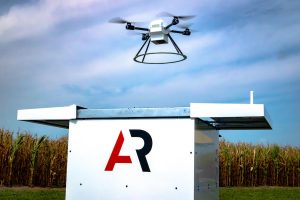American Robotics Advances Its Autonomous Drone Approval

The American Robotics Scout, FAA-approved for non-operator use. Photo courtesy of American Robotics.
Keeping track of materials—making, moving, tracking and consuming them—can be hard. Which is why Redmond, Washington-based Stockpile Reports has carved out a niche providing dashboards and other information to material producers and handlers. According to company CEO David Boardman, “the bulk materials industry suffers chronic financial write-offs due to a lack of accurate inventory data and various shrinkage scenarios. Stockpile Reports helps customers monitor this, using on-demand measurements from image processing.”
Yet while barcodes and RFID can help keep track of things in boxes or with a printable surface, it’s more difficult to tracks piles of rock, lumber and other material. “There’s not a lot of tech,” Boardman noted in a recent TRUX industry podcast.
“It’s a massive problem.”
Consequently, Boardman searched for autonomous drones to address the tracking problem—for two years before he connected with American Robotics, the Marlborough, Massachusetts-based company which, as previously reported in Inside Unmanned Systems, this past January received FAA approval to use its autonomous drones without human operators on site.
“I called them,” Boardman reported, “and said, ‘I’d like to buy 100.
“We’ve worked over the last four or five months to deeply integrate our products,” Boardman continued. “Now, if Stockpile Reports customers have a site where they need data every hour on stockpiles, they can configure that in our portal, and we can deploy one of the units. We can click a button to schedule it to get data ever hour. It just happens with no humans involved.”
The FAA approval allows Autonomous Robotics’ Scout System to monitor large areas of land—up to a 2-mile radius or roughly 12.5 square miles (8,000 acres)—around the clock. At the maximum altitude of 400 feet, a Scout System can cover 500-1000 acres per day, taking about two weeks to cover a full 2-mile radius. Batteries in each drone last roughly 30 minutes per flight and the drone can return to its base station about 20 times per day. To monitor longer linear distances such as rail tracks and pipelines, users can purchase additional systems.
“Autonomous drones are super-important,” Boardman added. “I think it’s going to be a really noisy industry over the next few years as the FAA regulations get sorted out.”
Bridging the Hardware-Data Divide
Reese Mozer, CEO and co-founder of American Robotics, notes how a new era allowing certain autonomous flights will lead the way to collecting vast troves of data. This, in turn, can transform industries including agriculture, rail, energy, infrastructure, mining and more. Mozer estimated that the global market for such drone data could reach $100 billion.
For Mozer, American Robotics’ Scout system—the drone, it’s base and the customer app—is a step towards bridging the divide between drone hardware and data, thus extending the reach of the commercial drone marketplace. “The commercial sector is the least mature drone market,” he noted, “because we’ve been stopped short by a number of factors,” obviously including BVLOS regulations.
Mozer goes so far as to say that the drone industry’s product can be considered as data rather than aircraft; and of the two commercial spaces—package delivery and data collection—data collection has the greatest potential.
He points to many potential uses in various industries, such as:
- Agriculture—changes in crop growth may signify disease
- Oil and gas pipelines—observed anomalies can signify leaks
- Solar energy—thermal-camera inspection can spot failed cells in solar arrays
- Nuclear energy—capturing thermal anomalies, security breaches and other situations
- Electrical utilities—broken wires and downed poles can be seen
- Railroads—spotting failures that could lead to train derailments or other disasters
- Bulk materials and stockpiles—can be monitored for use, shrinkage and other situations
- Mining—where a site can be checked for activity or anomalies
- Security—in a variety of situations.
Moving Forward
As shown by the work with Stockpile Reports, American Robotics has not been standing still since the FAA approval. Since then, AR has increased business development activity in key industrial sectors by 80% while allying itself with key technology providers.
- In June, it officially announced a de-facto existing partnership with Scientific Applications and Research Associates (SARA). AR uses SARA’s Terrestrial Acoustic Sensor Array (TASA), an acoustics-based aircraft detection technology, to identify other aircraft and maintain a safe distance.
- Then, in July, AR received a purchase order from a Fortune 100 oil and gas company, which it expects to lead to other key industrial markets. There are more than 90,000 oil and gas wells in the U.S. and 835 kilometers of pipeline require constant monitoring and inspection, according to a contemporary Business Wire
- In August, American Robotics was acquired by Ondas Holding of Sunnyvale, California, a developer of proprietary software-based broadband technology with experience in AR’s target markets. The partnership is expected to provide Ondas’ self-contained broadband networks for AR installations, which boost capabilities and performance for AR installations, many of which are in challenged radio frequency environments. AR continues to operate independently, and the Scout System, now equipped with Ondas’ FullMAX wireless technology, is providing Ondas customers with enhanced inspection capability.
- In October, Ondas announced that AR had entered into a strategic partnership with Dynam, a developer of artificial intelligence (AI) and machine learning (ML) capabilities. This will allow AR to integrate cutting-edge AI and ML techniques into its products and client engagements.
“It’s not about the flying,” Mozer added. “It’s about using the data for some kind of actionable insight. What the system unlocks is data that was previously unreachable.”
The post Bridging the Hardware-Data Divide – Inside Unmanned Systems appeared first on d0llars.
source https://d0llars.com/bridging-the-hardware-data-divide-inside-unmanned-systems/
No comments:
Post a Comment